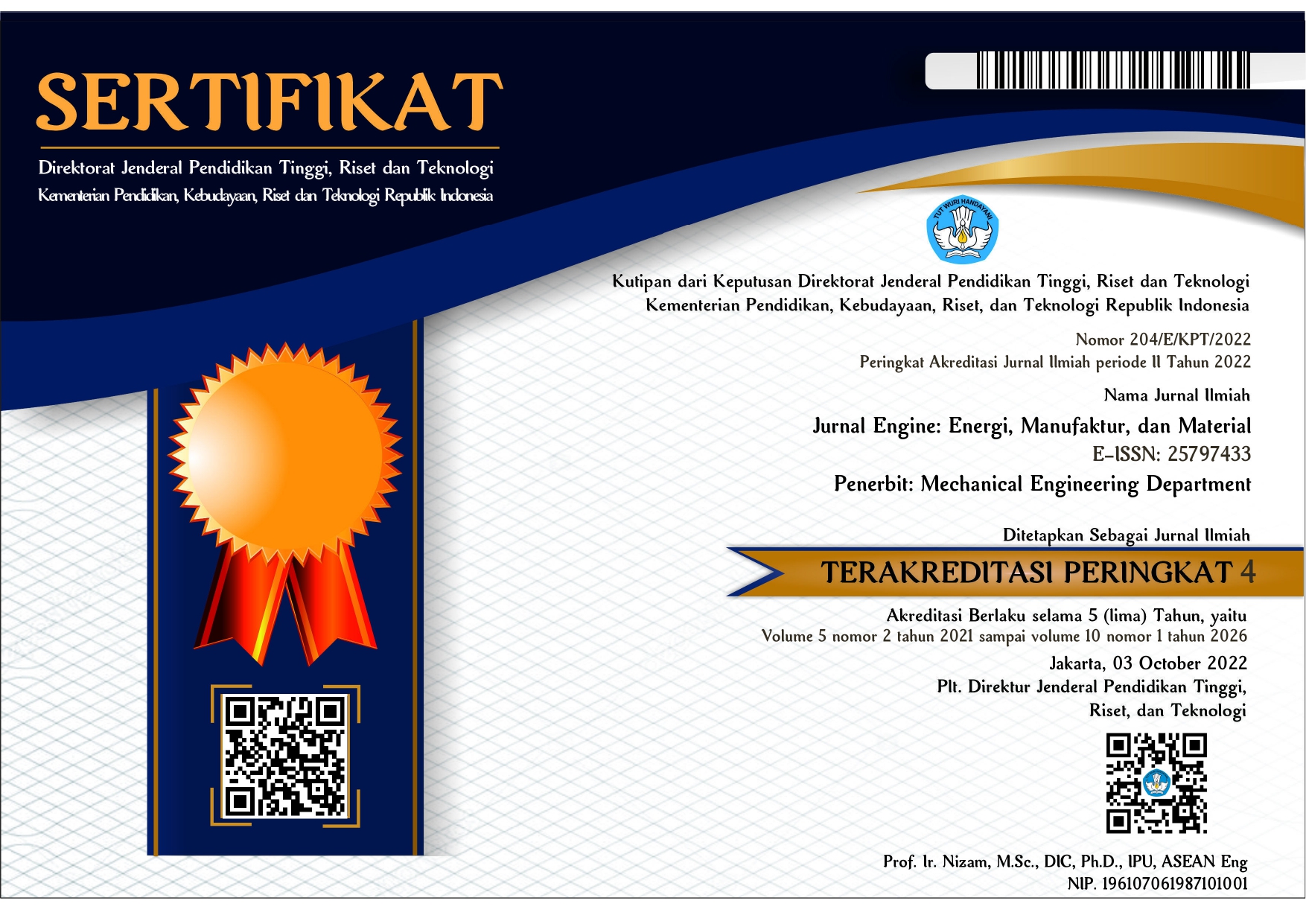Kajian Lingkungan dari Potensi Pembangkit Listrik Tenaga Surya di Energy Park Universitas Proklamasi 45
DOI:
https://doi.org/10.30588/jeemm.v7i1.1419Keywords:
Solar Power Plant, Energy Park, PVSyst, Potential Energy, grid-connectedAbstract
Indonesia is a country that is located right on the equator. This is certainly very supportive of one of the accelerations of Solar Power Plants. Proklamasi 45 University as a university in Yogyakarta that focuses on renewable energy plans to build an energy-themed location within the campus environment, named “Energy Park” with grid-connected Solar Power Plants as a source of electrical energy. This research aims to calculate the potential for electrical energy, its contribution to reducing CO2 emissions, and the feasibility of the Energy Park project from an economic point of view. The method used in this research is comparing data in the field and the system simulation method with PVsyst software as well as cash-flow analysis calculations. According to the results of the system simulation, the potential for electrical energy generated by rooftop grid-connected PV mini-grid each year is calculated at 8,310 kWh or 8.31 MWh, with details per kWp of 1528 kWh/kWp/year. Then the contribution of reducing CO2 emissions from the implementation of Energy Park’s Solar Power Plants with electricity production of 8.31 MWh/year for 30 years is 148,2 tCO2. Through cash-flow analyst calculations, it is known that the Energy Park’s Solar Power Plants project is not economically feasible when referring to the current selling price of electrical energy and the performance of the existing Energy Park’s Solar Power Plants.
References
Anwar, M. C. (2022, July 17). Money. (M. C. Anwar, Editor), from Kompas.com: https://money.kompas.com/read/2022/01/25/092706226/daftar-tarif-listrik-2022-beda-harga-listrik-subsidi-dan-non-subsidi?page=all [Accessed 28 07 2022]
Avinda, A. I., Karnoto, & Darjat. (2021). ANALISIS KELAYAKAN
EKONOMI PEMBANGKIT LISTRIK TENAGA SURYA DENGAN SISTEM ON GRID PADA PONDOK PESANTREN TANBIHUL GHOFILIIN KABUPATEN BANJARNEGARA. Transient, 686-692.
Chikate, V. B., & Sadawarte, Y. (2015). The Factors Affecting the Performance of Solar Cell. ICQUEST.
Dewan Energi Nasional. (2016). FAQ DEWAN ENERGI NASIONAL, from Dewan Energi Nasional Republik Indonesia: https://den.go.id/index.php/statispage/index/8-faq-dewan-energi-nasional.html#:~:text=Rencana%20Umum%20Energi%20Nasional%20adalah,mencapai%20sasaran%20Kebijakan%20Energi%20Nasional. [Accessed 21 05 2022]
Gunawan, L. A., Agung, A. I., Widyartono, M., & Haryudo, S. I. (2021). RANCANG BANGUN PEMBANGKIT LISTRIK TENAGA SURYA PORTABLE. Jurnal Teknik Elektro, 65-71.
Hidayat, A. (2014, April). Independen T Test dengan SPSS, from Statistikian: https://www.statistikian.com/2014/04/independen-t-test-dengan-spss.html. [Accessed 15 06 2022]
Hidayat, F. (2018). ANALISIS EKONOMI PERENCANAAN PEMBANGKIT LISTRIK TENAGA SURYA (PLTS) DI DEPARTEMEN TEKNIK ELEKTRO UNIVERSITAS DIPONEGORO. Transient, 875-882.
Hidayat, F., Winardi, B., & Nugroho, A. (2018). ANALISIS EKONOMI PERENCANAAN PEMBANGKIT LISTRIK TENAGA SURYA (PLTS) DI DEPARTEMEN TEKNIK ELEKTRO UNIVERSITAS DIPONEGORO. Jurnal Transient, 875-882.
ICED. (2018). Panduan Studi Kelayakan PLTS Terpusat. Jakarta: Direktorat Aneka Energi Baru dan Terbarukan, Ditjen EBTKE, KESDM.
Kementerian ESDM. (2012, June 19). Matahari Untuk PLTS di Indonesia, from Kementerian Energi dan Sumber Daya Mineral Republik Indonesia: https://www.esdm.go.id/id/media-center/arsip-berita/matahari-untuk-plts-di-indonesia#:~:text=Potensi%20energi%20surya%20di%20Indonesia,adalah%20sebesar%200.87%20GW%20atau [Accessed 12 02 2022]
Kristiawan, H., Kumara, I., & Giriantari, I. (2019). Potensi Pembangkit Listrik Tenaga Surya Atap Gedung Sekolah di Kota Denpasar. SPEKTRUM, 66-70.
Mustafa, P. S. (2017). Statistika Inferensial meliputi Uji Beda dalam Pendidikan Jasmani.
Napitupulu, R. (2017). PENGARUH MATERIAL MONOKRISTAL DAN POLIKRISTAL TERHADAP KARAKTERISTIK SEL SURYA 20 WP DENGAN TRACKINGSISTEM DUA SUMBU. Laporan Penelitian.
Nugroho, A. P., & Kurniawan, D. (2021). Potensi Pembangkit Listrik Tenaga Surya Rooftop di Gedung Mohammad Hatta, Universitas Proklamasi 45. Jurnal Offshore, 12-19.
Perserikatan Bangsa-Bangsa. (2022, Maret 18). Penyebab Dan Dampak Perubahan Iklim. from Perserikatan Bangsa - Bangsa Indonesia: https://indonesia.un.org/id/175273-penyebab-dan-dampak-perubahan-iklim#penyebab [Accessed 08 08 2022]
Pratama Pagan, S. E., Sara, I. D., & Hasan, H. (2018). Komparasi Kinerja Panel Surya Jenis Monokristal dan Polykristal Studi Kasus Cuaca Banda Aceh. Jurnal Online Teknik Elektro, 19-23.
PT. JASA TIRTA ENERGI. (2022). Penawaran Harga PLTS On-Grid Rooftop 5 kW. Yogyakarta: PT. JASA TIRTA ENERGI.
Putra, T. V. (2015). ANALISA UNJUK KERJA PEMBANGKIT LISTRIK TENAGA SURYA 15 KW DI DUSUN ASAH TEBEN DESA DATAH KARANGASEM. Tugas Akhir.
PVSyst. (2020). Tutorial PVsyst 7 Grid-connected.
Rafli, Ilham, J., & Salim, S. (2021). Perencanaan dan Studi Kelayakan PLTS Rooftop Pada Gedung Fakultas Teknik UNG. Jambura Journal of Electrical and Electronics Engineering, 8-15.
Ramadhani, I. (2018). Instalasi Listrik Tenaga Surya Dos & Don'ts. Jakarta: Energising Development.
Ramdan, D. M. (2021, Agustus 17). Nasional. from kontan.co.id: https://nasional.kontan.co.id/news/indonesia-harus-merdeka-dari-ketergantungan-energi-fosil [Accessed 17 05 2022]
Ridho, M. A., Winardi, B., & Nugroho Agung. (2018). ANALISIS POTENSI DAN UNJUK KERJA PERENCANAAN PEMBANGKIT LISTRIK TENAGA SURYA (PLTS) DI DEPARTEMEN TEKNIK ELEKTRO UNIVERSITAS DIPONEGORO MENGGUNAKAN SOFTWARE PVSYST 6.43. TRANSIENT, 883-890.
Rizkiana, A. F. (2022, February 20). Tekno & Sains. from kumparan.com: https://kumparan.com/aldila-fajar-r-r/urgensi-plts-melihat-potensi-dan-inovasi-di-bidang-energi-terbarukan-1xXmbIf01h8/full [Accessed 17 05 2022]
Setya Budi, R. F., & Suparman. (2013). PERHITUNGAN FAKTOR EMISI CO2 PLTU BATUBARA DAN PLTN. Jurnal Pengembangan Energi Nuklir.
Shaahid, S. (2011). Review of research on autonomous wind fams and a solar parks and their feasibility for commercial loads in hot regions. Renewable and Sustainable Energy Reviews, 3877-3887.
Soualmia, A., & Chenni, R. (2018). Performance Analyses of Grid-Connected Photovoltaic Power System. The Journal of Renewable Energies, 623-634.
Tira, H. S., Natsir, A., & Iqbal, M. R. (2018). Pengaruh Sudut Surya Terhadap Daya Keluaran Sel Surya 10 WP Tipe Polycristalline. Jurnal Teknik Mesin, 69-74.
United Nations. (2021, April). What is Climate Change? from United Nations: https://www.un.org/en/climatechange/what-is-climate-change [Accessed 08 08 2022]
US-EPA. (2022, May 05). Understanding Global Warming Potential. from United States Environmental Protection Agency: https://www.epa.gov/ghgemissions/understanding-global-warming-potentials [Accessed 08 08 2022]
Downloads
Published
How to Cite
Issue
Section
License
Authors who publish with Jurnal Engine: Energi, Manufaktur, dan Material agree to the following terms:
Authors retain copyright and grant the Jurnal Engine: Energi, Manufaktur, dan Material right of first publication with the work simultaneously licensed under a Creative Commons Attribution 4.0 International License that allows others to share (copy and redistribute the material in any medium or format) and adapt (remix, transform, and build upon the material) the work for any purpose, even commercially with an acknowledgment of the work's authorship and initial publication in Jurnal Engine: Energi, Manufaktur, dan Material. Authors are able to enter into separate, additional contractual arrangements for the non-exclusive distribution of the journal's published version of the work (e.g., post it to an institutional repository or publish it in a book), with an acknowledgment of its initial publication in Jurnal Engine: Energi, Manufaktur, dan Material. Authors are permitted and encouraged to post their work online (e.g., in institutional repositories or on their website) prior to and during the submission process, as it can lead to productive exchanges, as well as earlier and greater citation of published work (See The Effect of Open Access).


















